How much do you have to know to become a strong chess player?
According to Russian folklore you have to know 300 chess positions to become a grandmaster, but nobody knows what exactly these positions are.
There is something in the number 300 that attracts chess writers. Siegbert Tarrasch, one of the world's finest players from 1890 till World War One, taught chess in his book Three Hundred Chess Games. Vassily Panov presented in Russian 300 Selected Games of Alexander Alekhine with the notes of the former world champion.
In his book GM-Ram, IM Rashid Ziyatdinov prints 256 plain diagrams and asks you to fill in the remaining 44 positions. This is your chess brain, he says, but he doesn't tell you what to do with it. No text, no words - you are on your own. Once you acquire the "essential grandmaster knowledge" of these positions, chess is easy. Off you go, mastering the game and becoming a grandmaster. He also added 59 classical games without notes. "To be World Champion - at the level of Alekhine and Kasparov -you must know 1,000 most important games of top players," he claims.
The English grandmaster John Nunn gets to the number 300 differently. Instead of positions, he discusses ideas. His book Understanding Chess Endgames is a wonderful presentation of 100 key endgame ideas. Each idea has four fragments. The follow-up is Understanding Chess Middlegames, consisting of 100 important topics, each treated with two examples. Altogether, there are 300 ideas and more. No need to write Understanding Chess Openings, although one finds many rich opening ideas in Nunn's Understanding Chess Move by Move and 101 Brilliant Chess Miniatures. All Nunn's books were published by Gambit Publications.
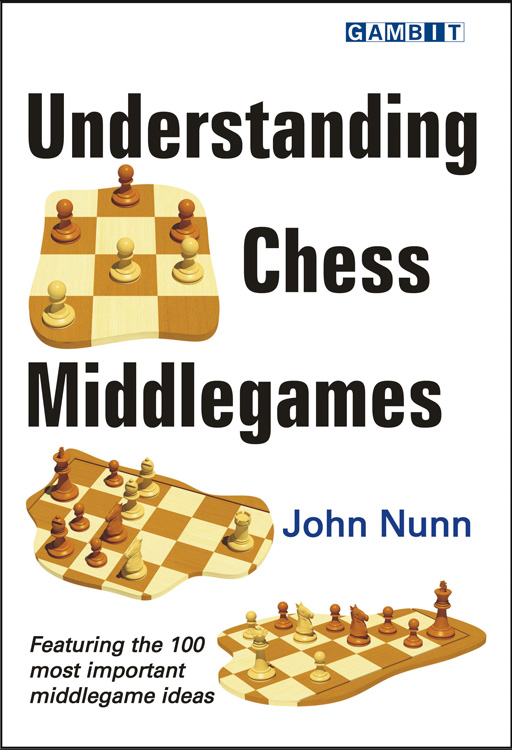
In one of the first chapters of his middlegame treatise, Nunn reveals one of the main points of middlegame play: "All parts of the board are connected. Plans, strategies and tactics that occur in one area of the board can impact another part of the board in unexpected ways." He calls it "interconnectedness," but perhaps it has more to do with synchronicity. Butterfly flaps its wings in China, triggering an earthquake in California. White's dark bishop sneezes on the queenside, the black king catches a cold on the kingside. Something like that.
To prove the point, Nunn connects two games with the same theme: Botvinnik-Capablanca, one of the most famous games in history, and my game with Uhlmann from the 1976 Manila Interzonal. There are similarities: white plays the move a3-a4, only to lose the a-pawn later. But it opens the diagonal a3-f8 for his dark bishop, helping him to finish a successful kingside attack.
Mikhail Botvinnik's glamorous game against Jose Raul Capablanca in the elite AVRO tournament, played in Rotterdam in 1938, drew attention for other reasons. Not only did a spectator shout out loud the key move of the winning combination before it was played, but it turned out Botvinnik could have won the game earlier without sacrificing his pieces. Richard Cantwell, a Fairfax dentist and veteran of the Washington D.C. chess scene, discovered this more than 60 years after it was played.
For many years the game was Botvinnik's calling card, published all over the globe. Not surprisingly, the game found its way into Garry Kasparov's book On My Predecessors, Volume Two, published by Everyman Chess. But Cantwell found additional improvements, notably on the 1988 analysis by Moscow master Vladimir Goldin, cited by Kasparov.
Botvinnik - Capablanca
AVRO, Rotterdam 1938
(To replay the game, scroll to the end of the article.)
1.d4 Nf6 2.c4 e6 3.Nc3 Bb4 4.e3 d5 5.a3 Bxc3+ 6.bxc3 c5 7.cxd5 exd5 8.Bd3 0-0 9.Ne2 b6 10.0-0 Ba6
(Botvinnik explained that the light bishop on d3 is the most unpleasant piece for black in this variation of the Nimzo-Indian defense. Capablanca tries to exchange it.)
11.Bxa6
(The best way to prepare the pawn advance in the center is 11.f3!, introduced by Viacheslav Ragozin in 1948. The rapid game Khalifman-Bologan, Prague 2002, continued 11...Re8 12.Ng3 Bxd3 13.Qxd3 Nc6 14.Ra2 Qd7 15.Re2 Re6 16.Bb2 Rd8 17.Rd1 cxd4 18.cxd4 Ne8 19.e4 Ne7 20.e5 Rc8 21.f4 with white's advantage.)
11...Nxa6 12.Bb2 Qd7
(White's dark bishop on b2 resembles a pawn, pegged into the chessboard without hopes for a bright future.)
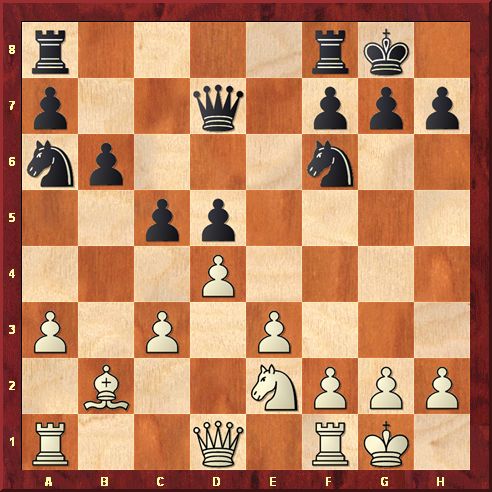
13.a4!?
("This move has far-reaching consequences. One alternative is 13.Qd3 , but after 13... 13...Qa4 the a3-pawn is blocked, which means that White no longer has the option of activating his bishop via a3. By playing a3-a4, White is willing to sacrifice the a-pawn, but if Black plays to win it, White both gains time and always has the possibility of Ba3 at the later stage. It's usually better to be a pawn down with active play than to have a passive and lifeless position with equal material." - John Nunn.
13...Rfe8?!
(Botvinnik points out that after 13...cxd4! 14.cxd4 Rfc8, with the idea to double the black rooks on the c-file, the initiative would go to black.)
14.Qd3 c4?!
(Black blocks the queenside and goes after the pawn on a4, but according to Botvinnik it is a positional error. White obtains a commanding position by advancing his e-pawn. The flexible 14...Qb7 was better.)
15.Qc2 Nb8
("Black takes the bait and plays to win the a-pawn by maneuvering his knight to b3. Black's last three moves have been criticized in various annotations, yet the odd thing is that the Deep Fritz 12 likes all of them. I suppose these days this would be taken as evidence that Black was cheating." - John Nunn)
16.Rae1 Nc6 17.Ng3 Na5 18.f3 Nb3 19.e4 Qxa4
(Both sides have achieved their goal, but white's attack is too powerful.)
20.e5 Nd7
(The fancy 20...Nc5? loses to 21.Re2!)
21.Qf2!?
(According to Goldin white should keep the queen on the b1-h7 diagonal and parry the threat Nb3-c5 with 21.Re2!, because the blockading strategy 21...g6 22.f4 f5 runs into a promising knight sacrifice 23.Nxf5! gxf5 24.Qxf5 and black can't cope with white's advancing pawns, for example 24...Qc6 25.e6 Nf8 26.Qf7+ Kh8 27.f5 Rac8 28.f6 Rc7 29.e7! and white wins.)
21...g6 22.f4 f5 23.exf6 Nxf6 24.f5 Rxe1 25.Rxe1 Re8 26.Re6 Rxe6 27.fxe6 Kg7 28.Qf4! Qe8
(Preventing 29.Nf5+!)
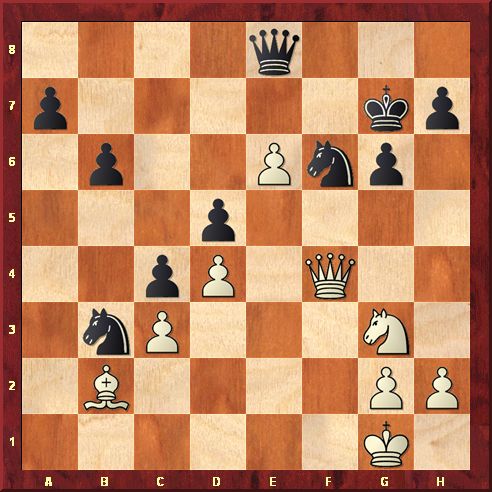
29.Qe5?!
(Botvinnik probably thought that pinning the knight is strong enough, but Cantwell discovered that white wins with 29.Qc7+!, a tactical maneuver to gain an important tempo after 29...Kg8 30.Qe5. It was published in the 2002 March issue of Chess Life. After 30...Kg7 white reaches the same position as in the game, but it is his move and he can continue 31.Ba3! [The bonus move!] 31...Na5 32.Qc7+ Kg8 33.Be7! and black is in trouble, for example 33...Ng4 34.h3 Nc6 35.Bg5 h6 36.Bd2 Nf6 37.Bxh6 and white should win. Whether Kasparov read Cantwell's findings or not, he concurs with him that after 30...Qe7 31.Ba3! Qxa3 32.Qxf6 Qf8 33.Qe5 Qe7 34.Qxd5 b5 35.Ne4 white wins.)
29...Qe7?!
(Playing into Botvinnik's astonishing combination. Goldin's major discovery was the defense 29...h6, controlling the square g5. When he informed Botvinnik about it, the former world champion suggested 30.Ba3, to which Goldin's 30...Qd8! prevents the queen invasion.
But Cantwell found that 30.Qd6!, dominating the black queen, gives white excellent winning chances, for example
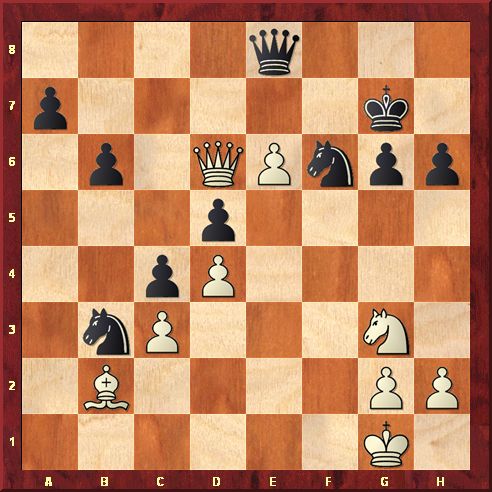
A. 30...a5 31.Ba3 b5 32.Qc7+ Kh8 33.Be7 Ng8 34.Qe5+ Kh7 35.Bd6 a4 [or 35...b4] 36.Nh5! gxh5 37.Qf5+ Qg6 38.Qf7+ and white wins.
B. 30...Qf8 31.Qc7+ Kh8 [31...Kg8 32.Ba3!] 32.Qe5 Kg7 33.h4 Na5 34.h5 Nc6 35.Qc7+ Ne7 36.Ba3 Nfg8 37.Qd7 and black is tied up.
C. 30...Na5 31.Bc1! [threatening 32.Qc7+ and 33.Bxh6, winning.] 31...Nc6 32.Qc7+ Ne7 33.Qxa7 with a clear advantage.
30.Ba3!!

(A wonderful deflection. Nunn calls it one of the most famous combinations of all time. During the 1954 chess olympiad in Amsterdam the celebrated position made it on an enormous cake displayed in the window of a local bakery. Botvinnik tells a story how the Russian computer "Pioneer" analyzed this position in 1979. To Botvinnik's disappointment it first suggested 30.Nf5, but later it found 30.Ba3!!
"I wish to emphasize that the combination with 30.Ba3!! wasn't just a fortuitous accident of which Botvinnik was able to take advantage. While he could not have foreseen the specific use to which it was put, Botvinnik was surely aware when he played a3-a4 that the availability of the square a3 was a potential asset." - John Nunn)
30...Qxa3 31.Nh5+!
(Before Botvinnik could play this move, one of the spectators in Rotterdam shouted it out loud. The knight sacrifice is the key to Botvinnik's combination allowing the white queen to help promote the e-pawn.
"As if to emphasize the interconnectedness of various parts of the board, these two deadly blows took place on opposite rook's files." - John Nunn.)
31...gxh5 32.Qg5+ Kf8 33.Qxf6+ Kg8 34.e7
(Kasparov suggested another win: 34.Qf7+ Kh8 35.g3! and the white king hides on h3.)
34...Qc1+ 35.Kf2 Qc2+ 36.Kg3 Qd3+ 37.Kh4 Qe4+ 38.Kxh5 Qe2+
(Botvinnik gives 38...Qg6+ 39.Qxg6+ hxg6+ 40.Kxg6 and 41.e8Q mate.)
39.Kh4 Qe4+ 40.g4 Qe1+ 41.Kh5 (No more checks.) Black resigned.
Nunn combines the Botvinnik-Capablanca encounter with the following game because white helps his kingside attack by placing his dark bishop on a3. But it was not what I was going to do. I wanted to place on the square a3 my Queen!
I came to the 1976 Manila Interzonal with a wonderful second, Jan Timman. The Dutch grandmaster was about to move up among the world-class players, but he was not there yet. Snatching him was a great deal. It might have been the last time Jan took a coaching job.
The French Winawer was Timman's domain. He played it with both colors, but with the black pieces he suffered against two Yugoslav players, Bojan Kurajica and Albin Planinec. Before my game against Uhlmann, Timman's experience came in handy. We knitted several ideas together and they worked perfectly.
Kavalek - Uhlmann
Manila Interzonal 1976
(To replay the game, scroll to the end of the article.)
1.e4 e6 2.d4 d5 3.Nc3 Bb4 4.e5 Ne7 5.a3 Bxc3+ 6.bxc3 c5 7.a4
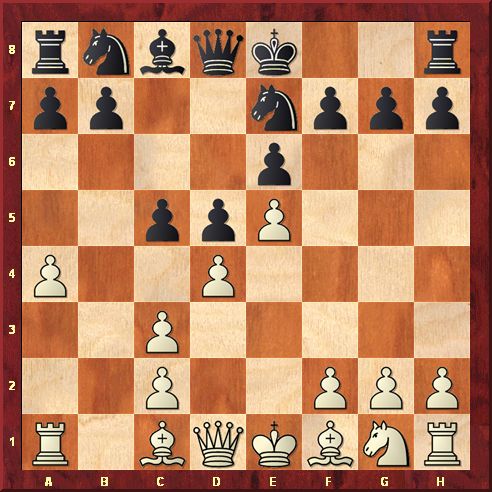
("Although the position is quite different from that in Botvinnik - Capablanca (AVRO, Rotterdam 1938), the ideas have certain similarity. If White omits a4, then Black can occupy the a4-square himself, either by Qa5-a4 or by Bd7-a4. This has the effect of reducing the long-term activity of White's dark-squared bishop and gives Black extra squares which he can use to exploit White's weak queen-side pawns. This is a question of opening theory, and those who play the French with either color are well aware of the significance of the a4 advance. In an echo of Botvinnik-Capablanca, playing a4 indicates a willingness to sacrifice this pawn at a later stage." - John Nunn
Two games were important for me to know before I faced Uhlmann. They dealt with the break f4-f5 on the kingside. 7.Nf3 Nbc6 8.Be2 Qa5 9.Bd2 c4 10.Ng5 h6 11.Nh3 Ng6 Botvinnik's plan to dwarf white's attack on the kingside. He played it against Smyslov in the Soviet championship in 1944. Planinec found a nice way to counter it. 12.a4 Bd7 13.0-0 0-0-0 14.Bh5 Nce7 15.Qe1 Kb8 16.Bc1 [16.f4 Ka8 17.Bc1 f5 18.exf6 gxf6 19.f5! exf5 20.Ba3 Rhe8 21.Qd2 Rg8 22.Bb4 Qc7 23.Rae1 Bxa4 24.Nf4 Qd7 25.Rf2 b6 26.Rfe2 Nxf4 27.Rxe7 Nxg2 28.Rxd7 Nxe1+ 29.Kf1 Rxd7 30.Qxe1 Rg5 31.h4 Rxh5 32.Qe8+ Kb7 33.Qxh5 a5 34.Bf8 Bxc2 35.Qxh6 Be4 36.Qxf6 1-0 Planinec,A (2525)-Timman,J (2470)/Amsterdam 1973] 16...Rc8 17.Ba3 Qd8 18.a5 Rg8 19.Qc1 Rc6 20.a6 b6 21.f4 f5 22.exf6 gxf6 23.f5! Nxf5 24.Rxf5 exf5 25.Qxh6 f4? 26.Bxg6 Bxh3 27.Qxh3 Rxg6 28.Qh7 1-0 Planinec,A (2545)-Timman,J (2540)/Amsterdam 1974.)
7...Nbc6 8.Nf3 Qa5 9.Bd2
(Jan Timman had this to say: "In the past 9.Qd2 has been generally considered to be the best move. Svetozar Gligoric once wrote that with 9.Bd2 White is giving up two positional trumps: posting the bishop on the a3-f8 diagonal and the possibility of eventually bringing the queen to the king-side - on f4 or g5. But in practice it has been proved that after 9.Qd2 Bd7 Black can free himself since the permanent threat of ...cxd4 is hanging in the air. This just shows how complicated are the problems associated with the doubled c-pawn. In the first round of the 1976 Skopje tournament Bojan Kurajica proved against me that with 9.Bd2 white keeps the positional trumps in hand: the white queen can go to a3 (via c1) threatening to march deep into Black's territory via d6, and white's dark-squared bishop can find a powerful life on the h2-b8 or h4-d8 diagonal after White's e-pawn is exchanged for Black's f-pawn."
In simple terms, the white queen can take the role of the dark bishop and go to the diagonal a3-f8.)
9...Bd7 10.Be2 c4
(The game was played before Viktor Korchnoi began to chip away at white's center with 10...f6.
Another way how to cope with the threat 11.c4 is 10...Qc7. The game Kurajica-Timman, Skopje 1976 continued: 11.0-0 0-0 12.Re1 h6 13.Qc1! Kurajica found this move after his game against Langeweg, Wijk aan Zee 1976. Timman knew about it and prepared 13...f6 but Kurajica surprised him with 14.exf6! [After 14.Bxh6 fxe5! 15.Be3 e4 white doesn't have much.] 14...Rxf6 15.Qa3! c4 16.Ne5 and suddenly black had many problems. The unusual maneuver Qd1-c1-a3 was born.)
11.Ng5
(After the center is blocked, White has to hurry up to seize the initiative on the kingside.)
11...h6
(Not 11...f6? 12.Bh5+! Ng6 13.Nxh7 Kf7 14.Ng5+ fxg5 15.Qf3+ and white wins.
The game Timman-Uhlmann, Skopje 1976, went 11...0-0 12.0-0 f6 13.exf6 Rxf6 14.Bg4 h6 15.Nf3 and white was better. Timman continued with Kurajica's queen maneuver 15...Nc8 16.Re1 Nb6 17.Qc1! Raf8 18.Qa3 Nd8 19.Ne5! Qxa4 [After 19...Rxf2 Timman prepared 20.Rf1 Rxf1+ 21.Rxf1 Rxf1+ 22.Kxf1 Qxa4 23.Qe7 and the black position is collapsing.] 20.Qc1 Qb5 21.Rxa7 and Timman thought white had achieved an ideal position in the Winawer variation: the weak a-pawn disappeared from the board, White firmly controls the central squares and black's bishop has no play. It was clear Uhlmann had to come up with something else for our game.)
12.Nh3 0-0-0
(After 12...Ng6 I would apply Planinec's ideas mentioned above.)
13.Nf4 Kb8
(I was not sure what was the idea behind the mysterious move, but Uhlmann was simply preparing to go after my a-pawn. Such a strategy is common in the Winawer: once we lose a step with our opponent in a positional struggle, we better get something for it. Losing the a-pawn makes no difference for white as long as his initiative on the kingside remains alive. It is a positional gambit.
Preventing the knight landing on h5 with 13...g6 doesn't work well. In the following game, white was able to transfer the bishop to a3: 14.0-0 Kb8 15.Qe1 Nc8 16.Bc1 Nb6 17.Ba3 Nxa4 18.Bd6+ Kc8 19.Ra3 Rde8 20.Qa1 Nd8 21.Rb1 Bc6 22.Bb4 Qa6 23.Nd3!! cxd3 24.cxd3 Kd7 25.c4 b6 26.Bd1 Qb7 27.Bxa4 Bxa4 28.Rxa4 Nc6 29.Bd6 Ra8 30.Rb5 Ne7 31.Bxe7 Kxe7 32.Qa3+ Ke8 33.cxd5 exd5 34.Ra6 Rc8 35.Rb1 Rc7 36.Ra1 1-0 Liberzon,V-Van den Broeck,H/Reykjavik 1975.
White has a clear advantage after 13...f6 14.exf6 gxf6 15.Bg4 e5 16.Bxd7+ Rxd7 17.Nh5!)
14.0-0 Nc8
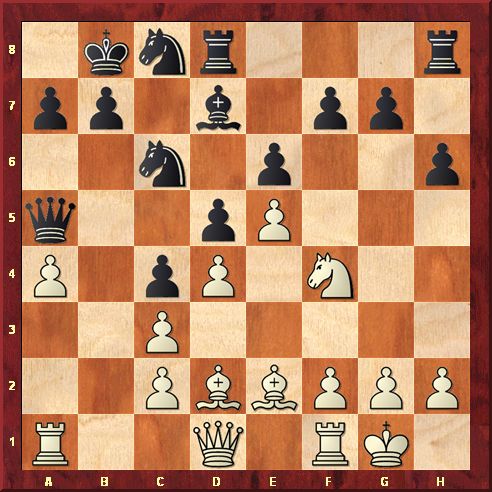
("Black is playing to win the a4-pawn with Nb6. Here White's compensation for the a-pawn is perhaps less obvious than in Botvinnik-Capablanca, since his Bishop is currently on d2 and cannot immediately exploit the potential of the a3-f8 diagonal. Moreover, there is no mobile pawn-majority. However, Black's plan to capture the a-pawn is quite slow and White is able to use the time to attack Black's vulnerable kingside." - John Nunn)
15.Nh5
(After freezing black's kingside with the knight, white can gradually prepare the break with the f-pawn.)
15...Rhg8 16.Bg4 Nb6 17.Re1
(Killing two birds with one stone: the rook goes to the third rank where it can protect the c-pawn and tackle black's kingside at the same time.)
17...Nxa4
(Finally, black won the pawn, but it took him some time. The knight is also out of play.)
18.Re3 b5 19.Rf3 Be8 20.Rg3 Ne7
("For the moment Black has countered White's kingside threats, but with the c3-pawn defended by the rook, White is free to play his bishop to a3." - John Nunn)
21.Bc1!
(The bishop is going to the diagonal a3-f8 to help the decisive breakthrough on the king side.)
21...Ng6 22.Ba3 Ka8 23.Qd2 Qc7 24.Bh3 Bd7 25.Bd6 Qc6 26.Rf1!
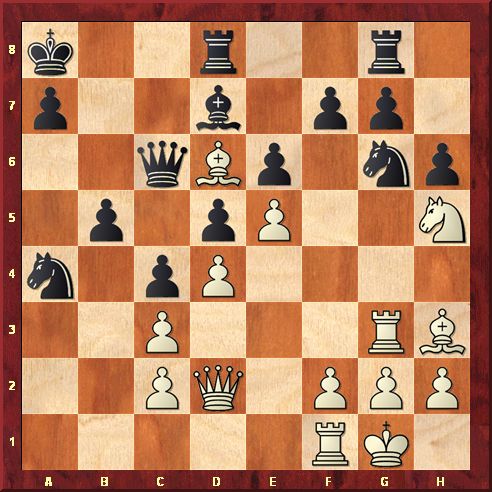
("White is now ready for f4-f5, breaking open Black's position. Black is handicapped not only by his weak dark squares, but also by the knight on a4 (which corresponds to the b3-knight in Botvinnik-Capablanca), which is out of play and cannot participate in the defense." - John Nunn)
26...Bc8 27.f4 f5!?
(Uhlmann blockades the kingside, using tactics. The knight on g6 is unprotected, but after 28.Rxg6 comes 28...Qe8! and black wins the piece back. However, white has his own tactical magic.)
28.exf6! gxf6
(After 28...Qxd6 29.f7! Rgf8 30.Rxg6 Rxf7 31.Nxg7 white will win the pawn on e6 soon.)
29.f5!
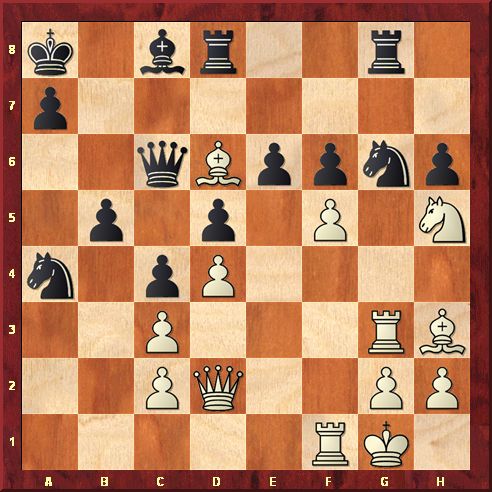
(Planinec's original idea becomes thematic. The hanging bishop on d6 adds an esthetic value.)
29...exf5 30.Bb4
(White's main task from now on is to collect black's weak pawns on the kingside. Also, the control of the e-file becomes decisive.)
30...Qb6 31.Bxf5 a5 32.Bxa5?
(I almost spoiled the hard work. The computers suggest the simple 32.Bxg6 axb4 33.cxb4 Rdf8 (33...Rd6 34.c3) 34.c3 f5 35.Bf7! with a big advantage.)
32...Qxa5 33.Bxg6 f5?
(We both missed 33...Nxc3! 34.Nxf6 Rg7 35.Nxd5!? Rxg6! [Not 35...Rxd5 36.Be4! and white wins.] and black is still in the game.)
34.Nf4 Rg7
("White has regained the sacrificed pawn and now has a decisive advantage. Black's position is riddled with pawn weaknesses, he has a bad bishop and his king is exposed." - John Nunn )
35.Re3 Qb6 36.Be8 Rd6 37.Rb1 Bd7 38.Qe1 Ka7 39.Rb4 Qd8 40.Bxd7 Qxd7 41.Rb1 Kb6 (A sealed move.) 42.Qe2 Kc6 43.Re1
(A triple harmony.)
43...Qa7 44.Re6 Qd7 45.Qf3 Nb6 46.Rxd6+ Kxd6 47.Qh5 Black resigned.
Previously played strategical and tactical ideas helped me to win the game. Who would have dreamt of Kurajica's and Planinec's plans before 1976?
Viktor Moskalenko, who likes exotic names and peppers his books with fresh, interesting ideas, wrote about the difficult opening in The Flexible French and The Wonderful Winawer. Both books, published by New In Chess, are great reads. But Kurajica's maneuver Qd1-c1-a3 went unnoticed.
Where to look for chess ideas...
Several books with original ideas are worth reading. Two were already mentioned in previous columns. Invisible Chess Moves by Yochanan Afek and Emmanuel Neiman, published by New In Chess. It won Chess Cafe's 2011 Book of the Year Award. The runner-up Lessons with a Grandmaster by Boris Gulko and Dr. Joel R. Sneed, published by Everyman Chess, is based on a Socratic dialog, previously used by Andrew Soltis in his chess books. Gulko dives deep into his games and explains them clearly and well.
Quality Chess has published various books by strong grandmasters. Artur Yusupov's series Boost your Chess, Beyond the Basics and Chess Evolution, The Fundamentals are great training tools. Lev Psakhis's Advanced Chess Tactics is a beautiful, witty sentimental journey into his past with a special tribute to the legendary attacker, the world champion Mikhail Tal.
Grandmaster Versus Amateur, edited by Jacob Aagaard and John Shaw, is a great attempt by several grandmasters to map their paths to the grandmaster title. Their struggles and triumphs are vividly described and have instructive value.
Amateurs who want to reach a more modest 2100 rating can always turn to Jeremy Silman's classic How to Reassess Your Chess. In the fourth almost completely re-written edition, the California IM delves into psychology. The 658-page epic book underscores Silman's trademark: how to balance chess imbalances.
Note that in the replay windows below you can click either on the arrows under the diagram or on the notation to follow the game.
